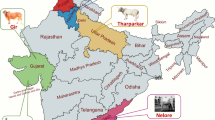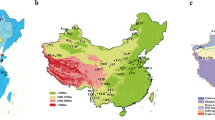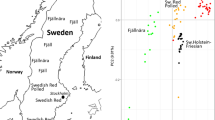Abstract
The aim of this study was to identify common candidate genes related to environmental adaptation including the cold climates in Russian native cattle and sheep breeds. We made use of our previously published data on candidate regions under selection in the genomes of nine Russian native cattle breeds and 15 Russian sheep breeds using two approaches: the hapFLK and DCMS. We choose one top gene per candidate region under selection for the present study. The total number of genes across all selected regions was 2143 for the cattle and 7706 for the sheep breeds (p-value < 0.05). Of these 1262 genes were shared between the two lists and potentially underwent positive selection in both species. Among them 31 genes were independently reported to be under selection in at least two species of cold-adapted Arctic mammals. Strikingly, the NEB gene, likely associated with heat production via shivering thermogenesis, was found in positively selected regions in the cattle, sheep, mammoth, polar bear, and whale genomes. The shared list of 1262 genes was enriched for genes that are expressed in the brain, uterus, and blood vessels. The latter group may be associated with adaptation to cold climates due to the known contribution of blood vessels to thermogenesis. Our analysis points to a list of shared genes which could be related to adaptation to cold climates in the Russian cattle and sheep breeds and animals from the Arctic region.

Similar content being viewed by others
REFERENCES
Parsons, P.A., Environments and evolution: interactions between stress, resource inadequacy and energetic efficiency, Biol. Rev. Cambridge Philos. Soc., 2005, vol. 80, no. 4, pp. 589—610.
Gompel, N. and Prud’homme, B., The causes of repeated genetic evolution, Dev. Biol., 2009, vol. 332, no. 1, pp. 36—47. https://doi.org/10.1016/j.ydbio.2009.04.040
Stern, D.L. and Orgogozo, V., Is genetic evolution predictable?, Science, 2009, vol. 323, no. 5915, pp. 746—751. https://doi.org/10.1126/science.1158997
Losos, J.B., Convergence, adaptation, and constraint, Evolution, 2011, vol. 65, no. 7, pp. 1827—1840. https://doi.org/10.1111/j.1558-5646.2011.01289.x
Storz, J.F., Causes of molecular convergence and parallelism in protein evolution, Nat. Rev. Genet., 2016, vol. 17, no. 4, pp. 239—250. https://doi.org/10.1038/nrg.2016.11
Fang, X., Seim, I., Huang, Z., et al., Adaptations to a subterranean environment and longevity revealed by the analysis of mole rat genomes, Cell Rep., 2014, vol. 8, no. 5, pp. 1354—1364. https://doi.org/10.1016/j.celrep.2014.07.030
Sun, X., Zhang, Z., Sun, Y., et al., Comparative genomics analyses of alpha-keratins reveal insights into evolutionary adaptation of marine mammals, Front. Zool., 2017, vol. 14, p. 41. https://doi.org/10.1186/s12983-017-0225-x
Foote, A.D., Liu, Y., Thomas, G.W., et al., Convergent evolution of the genomes of marine mammals, Nat. Genet., 2015, vol. 47, no. 3, pp. 272—275. https://doi.org/10.1038/ng.3198
Lambert, M.J., Nevue, A.A., and Portfors, C.V., Contrasting patterns of adaptive sequence convergence among echolocating mammals, Gene, 2017, vol. 605, pp. 1—4. https://doi.org/10.1016/j.gene.2016.12.017
Zhu, K., Ge, D., Wen, Z., et al., Evolutionary genetics of hypoxia and cold tolerance in mammals, J. Mol. Evol., 2018, vol. 86, no. 9, pp. 618—634. https://doi.org/10.1007/s00239-018-9870-8
Wilkins, A.S., Wrangham, R.W., and Fitch, W.T., The “domestication syndrome” in mammals: a unified explanation based on neural crest cell behavior and genetics, Genetics, 2014, vol. 197, no. 3, pp. 795—808. https://doi.org/10.1534/genetics.114.165423
Belyaev, D.K., Destabilizing selection as a factor in domestication, J. Hered., 1979, vol. 70, no. 5, pp. 301—308.
Prasolova, L.A. and Trut, L.N., Effect of the “Star” gene on the rate of melanoblast migration in silver fox (Vulpes vulpes) embryos, Dokl. Biol. Sci., vol. 329, nos. 1—6, pp. 787—789.
Larkin, D.M. and Yudin, N.S., The genomes and history of domestic animals, Mol. Genet. Microbiol. Virol., 2016, vol. 31, no. 4, pp. 197—202. https://doi.org/10.3103/S0891416816040054
Andersson, L., Genetic dissection of phenotypic diversity in farm animals, Nat. Rev. Genet., 2001, vol. 2, no. 2, pp. 130—138. https://doi.org/10.1038/35052563
Schmutz, S.M. and Berryere, T.G., Genes affecting coat colour and pattern in domestic dogs: a review, Anim. Genet., 2007, vol. 38, no. 6, pp. 539—549.
Cieslak, M., Reissmann, M., Hofreiter, M., and Ludwig, A., Colours of domestication, Biol. Rev. Cambridge Philos. Soc., 2011, vol. 86, no. 4, pp. 885—899. https://doi.org/10.1111/j.1469-185X.2011.00177.x
Reissmann, M. and Ludwig, A., Pleiotropic effects of coat colour-associated mutations in humans, mice and other mammals, Semin. Cell Dev. Biol., 2013, vol. 24, nos. 6—7, pp. 576—586. https://doi.org/10.1016/j.semcdb.2013.03.014
Fontanesi, L., Scotti, E., and Russo, V., Analysis of SNPs in the KIT gene of cattle with different coat colour patterns and perspectives to use these markers for breed traceability and authentication of beef and dairy products, Ital. J. Anim. Sci., 2010, vol. 9. e42. https://doi.org/10.4081/ijas.2010.e42
Yudin, N.S., Belonogova, N.M., and Larkin, D.M., Genes related to the white face colour pattern in eight Russian cattle breeds, Vavilovskii Zh. Genet. Sel., 2018, vol. 22, no. 2, pp. 217—223. https://doi.org/10.18699/VJ18.350
Yurchenko, A.A., Daetwyler, H.D., Yudin, N., et al., Scans for signatures of selection in Russian cattle breed genomes reveal new candidate genes for environmental adaptation and acclimation, Sci. Rep., 2018, vol. 8, no. 1, p.12984. https://doi.org/10.1038/s41598-018-31304-w
Yurchenko, A.A., Deniskova, T.E., Yudin, N.S., et al., High-density genotyping reveals signatures of selection related to acclimation and economically important traits in 15 local sheep breeds from Russia, BMC Genomics, 2019, vol. 20, Suppl 3, pp. 294. https://doi.org/10.1186/s12864-019-5537-0
Yurchenko, A., Yudin, N., Aitnazarov, R., et al., Genome-wide genotyping uncovers genetic profiles and history of the Russian cattle breeds, Heredity (Edinburgh), 2018, vol. 120, no. 2, pp. 125—137. https://doi.org/10.1038/s41437-017-0024-3
Fariello, M.I., Boitard, S., Naya, H., et al., Detecting signatures of selection through haplotype differentiation among hierarchically structured populations, Genetics, 2013, vol. 193, no. 3, pp. 929—941. https://doi.org/10.1534/genetics.112.147231
Ma, Y., Ding, X., Qanbari, S., et al., Properties of different selection signature statistics and a new strategy for combining them, Heredity (Edinburgh), 2015, vol. 115, no. 5, pp. 426—436. https://doi.org/10.1038/hdy.2015.42
Ballingall, K.T. and McKeever, D.J., Conservation of promoter, coding and intronic regions of the non-classical MHC class II DYA gene suggests evolution under functional constraints, Anim. Genet., 2005, vol. 36, no. 3, pp. 237—239. https://doi.org/10.1111/j.1365-2052.2005.01281.x
Wells, A., Kopp, N., Xu, X., et al., The anatomical distribution of genetic associations, Nucleic Acids Res., 2015, vol. 43, no. 22, pp. 10804—10820. https://doi.org/10.1093/nar/gkv1262
Mele, M., Ferreira, P.G., Reverter, F., et al., Human genomics: the human transcriptome across tissues and individuals, Science, 2015, vol. 348, no. 6235, pp. 660—665. https://doi.org/10.1126/science.aaa0355
Eden, E., Navon, R., Steinfeld, I., et al., Gorilla: a tool for discovery and visualization of enriched GO terms in ranked gene lists, BMC Bioinform., 2009, vol. 10, p. 48. https://doi.org/10.1186/1471-2105-10-48
Yudin, N.S., Larkin, D.M., and Ignatieva, E.V., A compendium and functional characterization of mammalian genes involved in adaptation to Arctic or Antarctic environments, BMC Genet., 2017, vol. 18, suppl. 1, p. 111. https://doi.org/10.1186/s12863-017-0580-9
Ottenheijm, C.A. and Granzier, H., Lifting the nebula: novel insights into skeletal muscle contractility, Physiology (Bethesda), 2010, vol. 25, no. 5, pp. 304—310. https://doi.org/10.1152/physiol.00016.2010
Labeit, S., Ottenheijm, C.A., and Granzier, H., Nebulin, a major player in muscle health and disease, FASEB J., 2011, vol. 25, no. 3, pp. 822—829. https://doi.org/10.1096/fj.10-157412
Li, F., Buck, D., De Winter, J., et al., Nebulin deficiency in adult muscle causes sarcomere defects and muscle-type-dependent changes in trophicity: novel insights in nemaline myopathy, Hum. Mol. Genet., 2015, vol. 24, no. 18, pp. 5219—5233. https://doi.org/10.1093/hmg/ddv243
Ottenheijm, C.A., Witt, C.C., Stienen, G.J., et al., Thin filament length dysregulation contributes to muscle weakness in nemaline myopathy patients with nebulin deficiency, Hum. Mol. Genet., 2009, vol. 18, no. 13, pp. 2359—2369. https://doi.org/10.1093/hmg/ddp168
Tansey, E.A. and Johnson, C.D., Recent advances in thermoregulation, Adv. Physiol. Educ., 2015, vol. 39, no. 3, pp. 139—148. https://doi.org/10.1152/advan.00126.2014
Rowland, L.A., Bal, N.C., and Periasamy, M., The role of skeletal-muscle-based thermogenic mechanisms in vertebrate endothermy, Biol. Rev. Cambridge Philos. Soc., 2015, vol. 90, no. 4, pp. 1279—1297. https://doi.org/10.1111/brv.12157
Nowack, J., Giroud, S., Arnold, W., and Ruf, T., Muscle non-shivering thermogenesis and its role in the evolution of endothermy, Front. Physiol., 2017, vol. 8, p. 889. https://doi.org/10.3389/fphys.2017.00889
Lee, S.H., Cho, Y.M., Lee, S.H., et al., Identification of marbling-related candidate genes in M. longissimus dorsi of high- and low marbled Hanwoo (Korean native cattle) steers, BMB Rep., 2008, vol. 41, no. 12, pp. 846—851.
Ilian, M.A., Bekhit Ael-D., Stevenson, B., et al., Up- and down-regulation of longissimus tenderness parallels changes in the myofibril-bound calpain 3 protein, Meat Sci., 2004, vol. 67, no. 3, pp. 433—445. https://doi.org/10.1016/j.meatsci.2003.11.016
Melody, J.L., Lonergan, S.M., Rowe, L.J., et al., Early postmortem biochemical factors influence tenderness and water-holding capacity of three porcine muscles, J. Anim. Sci., 2004, vol. 82, no. 4, pp. 1195—1205.
Franceschini, G., Apolipoprotein function in health and disease: insights from natural mutations, Eur. J. Clin. Invest., 1996, vol. 26, no. 9, pp. 733—746.
Defesche, J.C., Gidding, S.S., Harada-Shiba, M., et al., Familial hypercholesterolaemia, Nat. Rev. Dis. Primers, 2017, vol. 3, p. 17093. https://doi.org/10.1038/nrdp.2017.93
Chen, X.Y., Li, R., Wang, M., and Geng, Z.Y., Identification of differentially expressed genes in hypothalamus of chicken during cold stress, Mol. Biol. Rep., 2014, vol. 41, no. 4, pp. 2243—2248. https://doi.org/10.1007/s11033-014-3075-z
Panin, L.E., Poteryaeva, O.N., Dobronravova, O.V., and Kolpakov, A.R., Effect of long-term cold exposure on apoprotein A-1, B, and E levels in the rat serum, Ross. Fiziol. Zh. im. I.M. Sechenova, 1999, vol. 85, no. 2, pp. 263—267.
Bichkaeva, F.A., Kokoev, T.I., Dzhioeva, Ts.G., et al., The content of apolipoproteins A, B in the serum and the lipid metabolism parameters among residents of the subpolar regions of the North and the southern regions of the Caucasus, Klin. Lab. Diagn., 2013, no. 1, pp. 25—27.
Sweeney, H.L. and Hammers, D.W., Muscle contraction, Cold Spring Harb. Perspect. Biol., 2018, vol. 10, no. 2. pii a023200. https://doi.org/10.1101/cshperspect.a023200
Haman, F. and Blondin, D.P., Shivering thermogenesis in humans: origin, contribution and metabolic requirement, Temperature (Austin), 2017, vol. 4, no. 3, pp. 217—226. https://doi.org/10.1080/23328940.2017.1328999
Tan, C.L. and Knight, Z.A., Regulation of body temperature by the nervous system, Neuron, 2018, vol. 98, no. 1, pp. 31—48. https://doi.org/10.1016/j.neuron.2018.02.022
Acosta, G.B., Otero, L.M.E., and Rubio, M.C., Area-dependent changes in GABAergic function after acute and chronic cold stress, Neurosci. Lett., 1993, vol. 154, nos. 1—2, pp. 175—178.
Funding
The research was supported by the Russian Science Foundation grant (RSF, 19-76-20026).
Author information
Authors and Affiliations
Corresponding author
Ethics declarations
The authors declare that they have no conflict of interest. This article does not contain any studies involving animals or human participants performed by any of the authors.
Rights and permissions
About this article
Cite this article
Yudin, N., Larkin, D.M. Shared Signatures of Selection Related to Adaptation and Acclimation in Local Cattle and Sheep Breeds from Russia. Russ J Genet 55, 1008–1014 (2019). https://doi.org/10.1134/S1022795419070159
Received:
Revised:
Accepted:
Published:
Issue Date:
DOI: https://doi.org/10.1134/S1022795419070159




